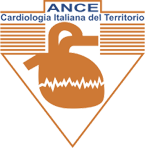Clinical Diagnosis of Electrical vs Anatomic Left Ventricular Hypertrophy
Rubriche
ASSEMBLEA SOCI ANCE/ETS
Convocazione
Scarica...
DICHIARAZIONI DI INTENTI
CANDIDATE/CANDIDATI
ORGANI NAZIONALI ANCE/ETS 2025-2028
PRESIDENTE DE GREGORIO CESARE VICE PRESIDENTE DE BENEDITTIS GIUSEPPINA MONTEMURRO VINCENZO SEGRETARIO NAZIONALE BIFERALI FABIO TRISOLINO GIUSEPPE CONSIGLIERI NAZIONALI 1 ALBANO SALVATORE 2 ARMELLANI VALTER 3 BARONI MAURIZIO 4 CALCATERRA GIUSEPPE 5 CARLA' GIOVANNI...
DESTINA IL TUO 5X1000 ad ANCE Cardiologia italiana del Territorio-ETS. Sostieni la formazione, prevenzione e la ricerca cardiovascolare
BANCA MONTE DEI PASCHI DI SIENA VIA SALARIA 231 - 00198 ROMA ABI 01030 CAB 03297 IBAN:...
European Journal of Internal Medicine
Earlier Prediction of Cardiovascular Risk with Epicardial Fat Assessment Giuseppe Calcaterra (a), Ron T. Vargheseb, (c), Maurizio Baroni (d), Alessandro Capucci (e), Fabio Angeli (f, g), Gianluca Iacobellis (b), Paolo Verdecchia (h), a Former Professor of Pediatric...

Most physician readers of Aro’s and Chugh’s elegant review of electrical and anatomic types of LVH and the implications will be puzzled by the concepts that electrical LVH (ECG/LVH) and anatomic LVH (echo/LVH and MRI/LVH) might be different entities, and that patients may have one form without the other. These concepts have been evolving over the past decade, and are perhaps most succinctly presented in the second report of the working group on the ECG diagnosis of LVH.1 Their mutual independence should not be too surprising when their origins are considered. The “anatomic” varieties of LVH are based on imaging techniques that are directly related to cardiac mass and configuration, whereas the “electrical” variety is a record of the sum of effects of the flow of ions across many individual myocardial cell boundaries in a specific sequence. Why should these very disparate methods produce the same result? The evolving evidence favors the conclusion that ECG/LVH may not directly relate to ventricular mass at all, but the relationship with LV mass and with anatomic LVH develops through their common relationship to a yet undefined pathophysiological state (or multiple states) that leads to LVH. The anatomic methods provide a better indication of LV mass, while the electrical method seems to be better as a predictor of CV risk and future CV disease.
My own group has recently demonstrated that each of the six ECG abnormalities used in deriving the Romhilt-Estes score, used for decades to “diagnose” LVH, is independent of the other five in prediction of CV diseases and CV mortality.2 Could each ECG abnormality be an electrical marker, indicating a separate and distinct pathophysiological process? Could these ECG abnormalities enable earlier diagnosis of genetic defects at the myocardial cell level that lead to myocardial fibrosis or other states that lead to myocardial dysfunction, arrhythmias, and hypertrophy? My own personal guess is that it is not hypertrophy that causes cardiac dysfunction, but it is the underlying pathophysiological state, and that the observations in the featured article should be viewed as important and as the forerunner of other observations regarding this new understanding of heart disease and its progression.
References